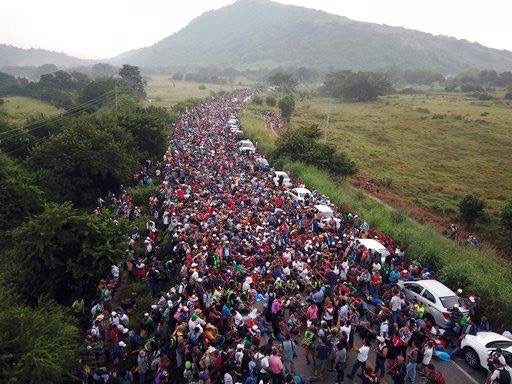The humanitarian crisis provoked by thousands of migrants that dream of obtaining asylum in the US has the entire region at crossroads.
With the deaths of 2 migrants from Central America that were travelling with the caravan that departed from San Pedro Sula, Honduras, on the 13th of October, the humanitarian crisis provoked by the precarious situation in which approx. 7000 (the figures vary) people are walking towards asylum and a better life in the US has intensified.
This new migratory crisis has put Central America in the international spotlight and it highlights the need to amplify debate surrounding the structural issues underlying this migratory phenomenon such as violence, inequality, and borders.
That is why we present 5 keys to understand the migrant caravan that is currently moving north throughout the continent.
1. It’s not the first caravan of this kind
According to Amnesty International, migrant caravans are not a new phenomenon. For many years, people from countries such as Honduras, El Salvador, and Guatemala have been migrating to escape violence.
Travelling in a large group is a strategy to protect themselves from the many dangers encountered on the journey through Mexico.
Travelling in a large group is a strategy to protect themselves from the many dangers encountered on the journey through Mexico.
Since 2010, the NGO ‘Pueblo sin Fronteras’, whose mission is to “build bridges of solidarity between populations and tear down walls built upon greed” organises caravans as a method of protest.
They protest the cruel reality that thousands of Central Americans fleeing violence towards the US suffer. Their first caravan attracted around 1500 people turned a social mobilisation into a mass migratory movement.
However, due to the size of the current movement and its impact on the international press, the most recent caravan of Hondurans has gained attention as a regional migratory phenomenon that heightens every day.
2. Mexico faces up to its own issues
Challenged by this new wave of migrants, Mexico must face itself in the mirror. Mexico is a country affected by high rates of violence, inequality and migration, and for years they have been requesting from the US new migratory policies that allow their citizens to legalise their status after crossing the border illegally.
For decades, ‘latinos’ have become a cheap, reliable and necessary labour force for the economic growth of the world, and far too many times their irregular status has pushed them towards slave labour, or precarious jobs.
The absence of regulated migratory policies have Mexico before great crossroads. Due to a combination of solidarity and lack of accountability, Mexican authorities have traditionally turned their back on the problem leaving the US government to deal with the migratory exodus towards the border.
The size of the current caravan and the humanitarian consequences this implies forces Mexico to face up to its contradictions.
We have seen significant demonstrations of Mexican solidarity towards the caravan, but also fear and tension regarding the future of many of these migrants that will most likely be unable to cross the northern border and that in the absence of public policies could fall into the hands of traffickers and organised crime that affects Mexico due to high rates of impunity.
3. The US as a place of refuge
Donald Trump has directly threatened to cut off humanitarian aid to Central American countries (when in reality he should double it to improve conditions), and to declare a national emergency thus sending troops to the border.
It’s clear that the caravan is seen not as a humanitarian or refugee crisis but as an issue of national security.
It’s clear that the caravan is seen not as a humanitarian or refugee crisis but as an issue of national security. Once again the asylum system in a country that has traditionally accepted many refugees fleeing towards a better future is in crisis.
In fact, the probability of the migrant caravan receiving asylum in the country is extremely low but they aren’t giving up, because they’re prepared to give up their lives in order to acchieve the American dream. In god we trust, as US dollars proclaim.
4. The narratives surrounding the caravan
The media have presented this crisis mainly as a wave of economic migrants, whitewashing over the true motive of the search of these migrants for a better life elsewhere.
The elevated levels of violence in Honduras, declared one of the most violent countries in the world, has reached a chilling 42 homicides per 100,000 inhabitants.
To understand this phenomenon, introducing violence in the equation is fundamental. Nobody is portraying this migrant caravan as what it may actually be in reality: a refugee crisis. This would change the frameworks for protection for these migrants that, in the case of obtaining refugee status, would have more guarantees of safety.
5. The future of the migrants
The caravan is full of babies, children and women. It is estimated that more than 1000 children make up this group for whom conditions worsen every day.
After days of walking under the sun, sleeping outdoors, malnourishment, exhaustion and blisters on the soles of their feet, the difficulties only accumulate further.
We can’t keep turning our backs on the thousands of lives that fight for an opportunity beyond the borders that confine them.
There are entire families travelling together in search of a new life far from the violence, poverty and lack of opportunities that have defined their existence.
Migrants are human beings and must be treated accordingly. Border walls have created a security fantasy for countries such as the US who believe that their zero tolerance approach will resolve the problem of migration.
The structural dimensions of this phenomenon should be dealt with on a regional scale. We can’t keep turning our backs on the thousands of lives that fight for an opportunity beyond the borders that confine them.










